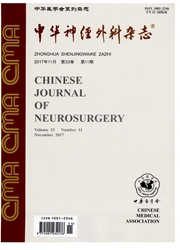

 中文摘要:
中文摘要:
目的观察骨髓基质干细胞(BMSCs)外分泌因子对损伤神经的保护作用。方法利用Transwell双室培养体系使BMSCs浸润于神经元裂解液中,酶联免疫吸附(ELISA)法测定细胞因子浓度;将BMSCs条件培养液加入经谷氨酸致伤的神经元表面,ELISA法和原位凋亡法检测乳酸脱氢酶(LDH)含量和凋亡细胞数量;条件培养液原位注射于大鼠创伤灶后予以动物神经功能缺陷综合评分。结果经神经元裂解液诱导后,BMSCs条件培养液中神经生长因子(NGF)、脑源性神经营养因子(BDNr)含量明显增加,基质衍生因子-1α(SDF-1α)、转化生长因子-β-1(TGF-β-1)含量变化差异无统计学意义;LDH含量和细胞凋亡数量随BMSCs条件培养液浓度的增加而降低;实验动物的神经运动功能明显好转。结论BMSCs外分泌因子对损伤神经元具有明确的保护作用,其中NGF和BDNF可能扮演重要角色。
 英文摘要:
英文摘要:
Objective To observe the protection effect of bone marrow stromal stem cells(BMSCs) excrine factors on damaged neurons. Methods BMSCs were cultured in neuron lysate through the transwell system. ELISA assay was used to test the concentration of excrine factors. The conditioned medium of BMSCs was added onto the damaged neurons induced by glutamate. Then ELISA and apoptosis in situ assays were used to test lactic acid dehydrogenase (LDH) level and apoptosis cell proportion. After the transplantation of conditioned medium, all the rats were given a mark for their nerve function. Results After induced by neuron lysate, BMSCs were highly expressed nerve growth factor(NGF) and brain -derived neurotrophic factor( BDNF), but stromal cell -derived factor (SDF) -lα and transforming growth factor (TGF) - β - 1 were no statistics difference. The LDH level and apoptosis cell proportion was negative correlation with the added BMSCs conditioned medium proportion. The results in vivo showed that the rats could obtain better scores of nerve function than control group. Conclusion The bone marrow stromal stem cells excrine factors have definitely protection effect on damaged neurons, and NGF and BDNF may play an important role in this event.
 同期刊论文项目
同期刊论文项目
 同项目期刊论文
同项目期刊论文
 期刊信息
期刊信息
